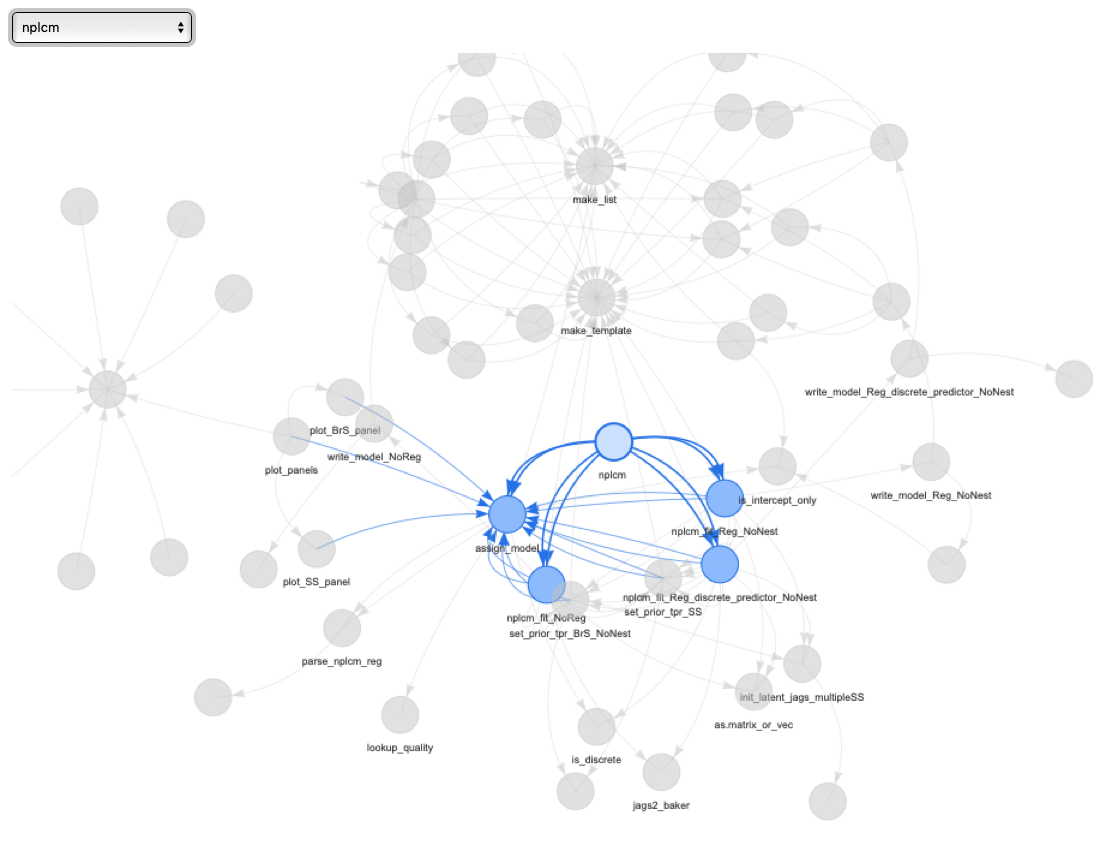

The hardware and bandwidth for this mirror is donated by dogado GmbH, the Webhosting and Full Service-Cloud Provider. Check out our Wordpress Tutorial.
If you wish to report a bug, or if you are interested in having us mirror your free-software or open-source project, please feel free to contact us at mirror[@]dogado.de.
An R Package for Fitting Bayesian Nested Partially Latent Class Models
Maintainer: Zhenke Wu, zhenkewu@umich.edu
Source Code: Please click here for source code on GitHub.
Issues: Please click here to report reproducible issues.
Vignette: Please click here to read the latest long-version vignette; a short version can be found here.
Package website: Please click here for a website generated by
pkgdown, which contains html format of the package manual
(“Reference”).
References: If you are using baker for population and individual estimation from case-control data, please cite the following papers:
There are a number of scientific papers on global health and infectious diseases that have used the model and some the software (in its earlier versions). Some notable examples are listed below:
R to
JAGS on Unix systems or OSXR to
JAGS on Windows# install.packages("devtools",repos="https://cloud.r-project.org")
devtools::install_github("zhenkewu/baker")Note:
install.packages("pbkrtest") for
R(>=3.2.3) if this package is reported as missing.devtools::install_github("zhenkewu/baker",INSTALL_opts=c("--no-multiarch"))
instead if you see an error message
ERROR: loading failed for 'i386' (Thanks Chrissy!).devtools::install_github("zhenkewu/baker", build_vignettes=TRUE) # will take extra time to run a few examples.
browseVignettes("baker")# install.packages("devtools",repos="http://watson.nci.nih.gov/cran_mirror/")
devtools::install_github("zhenkewu/baker")
shiny::runApp(system.file("shiny", package = "baker"))For developers interested in low-level details, here is a pretty awesome visualization of the function dependencies within the package:
library(DependenciesGraphs) # if not installed, try this-- devtools::install_github("datastorm-open/DependenciesGraphs")
library(QualtricsTools) # devtools::install_github("emmamorgan-tufts/QualtricsTools")
dep <- funDependencies('package:baker','nplcm')
plot(dep)You will get a dynamic figure. A snapshot is below:

baker.nplcm() that fits the model with or
without covariates.baker has implemented models for dependent measurements
given disease status, regression analyses of etiology, multiple
imperfect measurements, different priors for true positive rates among
cases with differential measurement characteristics, and
multiple-pathogen etiology.baker package is compatible with OSX, Linux and
Windows systems, each requiring a slightly different setup as described
below. If you need to speed up the installation and analysis, please
contact the maintainer or chat by clicking the gitter
button at the top of this README file.R to
JAGSR; Download from hereR, run R command
install.packages("rjags")R command library(rjags) in R console;
If the installations are successful, you’ll see some notes like
this:>library(rjags)
Loading required package: coda
Linked to JAGS 4.x.0
Loaded modules: basemod,bugsR command library(baker). If the
package ks cannot be loaded due to failure of loading
package rgl, first install X11 by going here,
followed byinstall.packages("http://download.r-forge.r-project.org/src/contrib/rgl_0.95.1504.tar.gz",repo=NULL,type="source")Here we use JHPCE as an example. The complete installation guide offers extra information.
Download source code for JAGS
4.2.0; The workflow would be similar for later versions of
JAGS.
Suppose you’ve downloaded it in ~/local/jags/4.2.0.
Follow the bash commands below:
# change to the directory with the newly downloaded source files:
cd ~/local/jags/4.2.0
# create a new folder named "usr"
mkdir usr
# decompress files:
tar zxvf JAGS-4.2.0.tar.gz
# change to the directory with newly decompressed files:
cd ~/local/jags/4.2.0/JAGS-4.2.0
# specify new JAGS home:
export JAGS_HOME=$HOME/local/jags/4.2.0/usr
export PATH=$JAGS_HOME/bin:$PATH
# link to BLAS and LAPACK:
# Here I have used "/usr/lib64/atlas/" and "/usr/lib64/" on JHPCE that give me
# access to libblas.so.3 and liblapack.so.3. Please modify to paths on your system.
LDFLAGS="-L/usr/lib64/atlas/ -L/usr/lib64/" ./configure --prefix=$JAGS_HOME --libdir=$JAGS_HOME/lib64
# if you have 8 cores:
make -j8
make install
# prepare to install R package, rjags:
export PKG_CONFIG_PATH=$HOME/local/jags/4.2.0/usr/lib64/pkgconfig
module load R
R> install.packages("rjags")
# or if the above fails, try:
R>install.packages("rjags", configure.args="--enable-rpath")Also check out the INSTALLATION
file for rjags package.
Again, I use JHPCE as an example.
#!/bin/bash
#$ -M zhenkewu@gmail.com
#$ -N baker_regression_perch
#$ -o /users/zhwu/baker_regression/data_analysis/baker_regression_test.txt
#$ -e /users/zhwu/baker_regression/data_analysis/baker_regression_test.txt
export JAGS_HOME=$HOME/local/jags/4.2.0/usr
export PATH=$JAGS_HOME/bin:$PATH
export LD_LIBRARY_PATH=$JAGS_HOME/lib64
cd /users/zhwu/baker_regression/data_analysis
#$ -cwd
echo "**** Job starts ****"
date
echo "**** JHPCE info ****"
echo "User: ${USER}"
echo "Job id: ${JOB_ID}"
echo "Job name: ${JOB_NAME}"
echo "Hostname: ${HOSTNAME}"
Rscript real_regression_data_jhpce.R
echo "**** Job ends ****"
dateR; Download from herebrew install -v jags for OSX,
sudo apt-get install jags for Ubuntu/DebianR, run R command
install.packages("rjags")Rtools
(for building and installing R packages from source); Add the path to
Rtools (e.g., C:\Rtools\) into your
environmental variables so that R knows where to find it.We provide two simulated data sets in the package:
data(data_nplcm_noreg)
data(data_nplcm_reg_nest)
These binaries (installable software) and packages are in development.
They may not be fully stable and should be used with caution. We make no claims about them.
Health stats visible at Monitor.